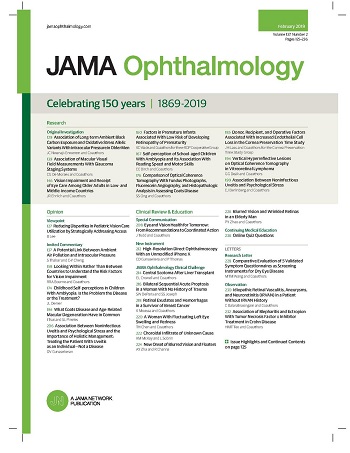Biallelic Loss-of-Function Variants in UBAP1L and Nonsyndromic Retinal Dystrophies.
IF 7.8
1区 医学
Q1 OPHTHALMOLOGY
引用次数: 0
Abstract
Importance Inherited retinal dystrophies (IRDs) present a challenge in clinical diagnostics due to their pronounced genetic heterogeneity. Despite advances in next-generation sequencing (NGS) technologies, a substantial portion of the genetic basis underlying IRDs remains elusive. Addressing this gap seems important for gaining insights into the genetic landscape of IRDs, which may help improve diagnosis and prognosis and develop targeted therapies in the future. Objective To provide a clinical and molecular characterization of 6 patients with IRDs with biallelic disease-causing variants in a novel candidate IRD disease gene. Design, Setting, and Participants This multicenter case series study included 6 patients with IRDs from 4 tertiary hospitals (in the US: National Eye Institute, National Institutes of Health Clinical Center; in the UK: Moorfields Eye Hospital, Royal Liverpool University Hospital, Birmingham Women's and Children's). Exposures Biallelic disease-causing variants in the novel candidate IRD disease gene, UBAP1L. Main Outcome and Measures Participants underwent comprehensive clinical ophthalmic assessments to characterize the features of retinal dystrophy. Exome and genome sequencing revealed candidate variants in the UBAP1L gene; no other plausible disease variants in known IRD genes were identified. A minigene assay provided functional insights for a noncanonical splice variant, and a knockout mouse model was used for in vivo functional elucidation. Results Four homozygous UBAP1L variants were identified in the affected individuals from 6 families, including 2 frameshift variants (c.710del and c.634_644del), 1 canonical splice variant (c.121-2A>C), and 1 noncanonical splice variant (c.910-7G>A), which was shown to cause aberrant splicing and frameshift in a minigene assay. Participants presented with retinal dystrophy including maculopathy, cone dystrophy, and cone-rod dystrophy. Single-cell RNA sequencing of the retina showed that human UBAP1L is highly expressed in both cones and retinal pigment epithelium, whereas mouse Ubap1l is highly expressed in cone cells only. Mice with truncation of the C-terminal SOUBA domain did not manifest retinal degeneration up to 15 months of age. Conclusions and Relevance Study results reveal clinical and genetic evidence that loss of UBAP1L function was associated with inherited retinopathy in humans. These findings hold promise for improved clinical diagnostics, prognosis, and the potential development of targeted therapies for individuals affected by IRDs.UBAP1L 和非综合征性视网膜营养不良症中的双拷贝功能缺失变异。
重要性遗传性视网膜营养不良症(IRDs)由于其明显的遗传异质性,给临床诊断带来了挑战。尽管下一代测序(NGS)技术在不断进步,但IRDs的遗传基础仍有很大一部分难以捉摸。解决这一空白似乎对深入了解 IRD 的遗传情况非常重要,这可能有助于改善诊断和预后,并在未来开发出靶向治疗方法。目的对 6 例在新型 IRD 候选疾病基因中存在双倍拷贝致病变异的 IRD 患者进行临床和分子特征描述:美国:国立眼科研究所、国立卫生研究院临床中心;英国:摩尔菲尔德眼科医院、皇家利兹大学眼科中心;美国:国立眼科研究所、国立卫生研究院临床中心:主要结果和测量参与者接受了全面的临床眼科评估,以确定视网膜营养不良症的特征。外显子组和基因组测序发现了 UBAP1L 基因的候选变异;在已知的 IRD 基因中未发现其他可能的疾病变异。一个微型基因测定为一个非典型剪接变体提供了功能性见解,一个基因敲除小鼠模型被用于体内功能阐释。del 和 c.634_644del)、1 个规范剪接变体(c.121-2A>C)和 1 个非规范剪接变体(c.910-7G>A)。参与者患有视网膜营养不良症,包括黄斑病变、视锥营养不良症和视锥-视杆细胞营养不良症。视网膜单细胞 RNA 测序显示,人的 UBAP1L 在视锥和视网膜色素上皮细胞中均高表达,而小鼠的 Ubap1l 仅在视锥细胞中高表达。截断了 C 端 SOUBA 结构域的小鼠在 15 个月大时没有表现出视网膜变性。研究结果揭示了 UBAP1L 功能缺失与人类遗传性视网膜病变相关的临床和遗传学证据。这些发现有望改善临床诊断和预后,并为受 IRD 影响的个体开发潜在的靶向疗法。
本文章由计算机程序翻译,如有差异,请以英文原文为准。
求助全文
约1分钟内获得全文
求助全文
来源期刊

JAMA ophthalmology
OPHTHALMOLOGY-
CiteScore
13.20
自引率
3.70%
发文量
340
期刊介绍:
JAMA Ophthalmology, with a rich history of continuous publication since 1869, stands as a distinguished international, peer-reviewed journal dedicated to ophthalmology and visual science. In 2019, the journal proudly commemorated 150 years of uninterrupted service to the field. As a member of the esteemed JAMA Network, a consortium renowned for its peer-reviewed general medical and specialty publications, JAMA Ophthalmology upholds the highest standards of excellence in disseminating cutting-edge research and insights. Join us in celebrating our legacy and advancing the frontiers of ophthalmology and visual science.
 求助内容:
求助内容: 应助结果提醒方式:
应助结果提醒方式:


